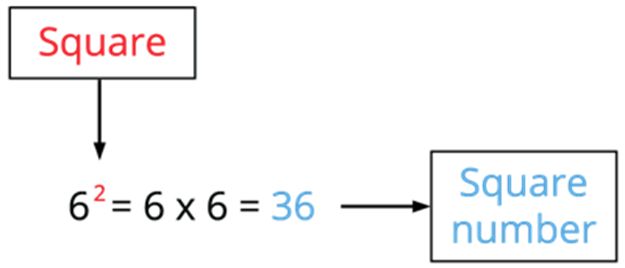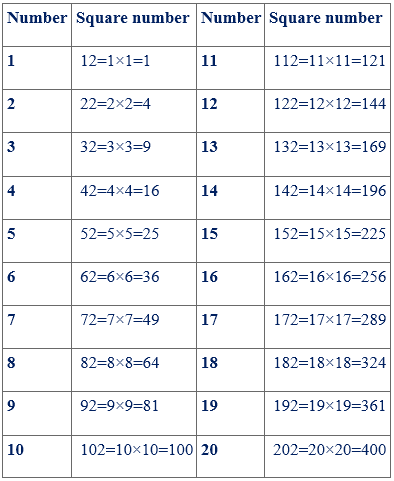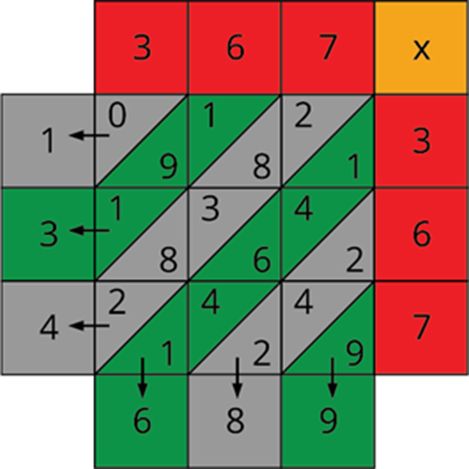- Books Name
- class 8 th Mathematics Book
- Publication
- ReginaTagebücher
- Course
- CBSE Class 8
- Subject
- Mathmatics
Square and Square Roots
Square Numbers
Introduction to square and square numbers
The first picture has 1 row and 1 column.
The second picture has 2 rows and 2 columns.
The third picture has 3 rows and 3 columns.
The fourth picture has 4 rows and 4 columns.
1×1=12=1
2×2=22=4
3×3=32=9
4×4=42=16

Here, we multiply the number by itself, and we obtained a square of that number.
The numbers 1, 4, 9 and 16 are called square numbers.
If a natural number (m) is expressed as a power of 2, then the number (m) is called a square number. That is m=n2. A square number is also called a perfect number.

The properties of square numbers
1. The square numbers end in 0, 1, 4, 5, 6 or 9 only.
2. If a number ends with 1 or 9, its square ends with 1.
3. If a number ends with 2 or 8, its square ends with 4.
4. If a number ends with 3 or 7, its square ends with 9.
5. If a number ends with 4 or 6, its square ends with 6.
6. If a number ends with 5 or 0, its square also ends with 5 or 0, respectively.
7. Square of an odd number is always odd, and the square of an even number is always even.
8. Numbers that end with 2, 3, 7 and 8 are not perfect squares.
Zero in the unit's place gets doubled itself if it is squared.
The below table shows the squares of the first 20 numbers:

Steps to find out the perfect square
To check whether the given natural number is a perfect square or not, we can follow the below steps:
Step 1. Write the given natural number as a product of prime factors.
Step 2. Now, group the factors in pairs so that both factors in each pair are equal.
Step 3. Now, see whether some factors are leftover or not. If no factor is leftover in grouping, then the given number is a perfect square. Otherwise, it is not a perfect square.
Step 4. Take one factor from each group and multiply them to obtain the number whose square is the given number.
All numbers are not perfect squares. If any number is not a perfect square, we need to multiply or divide the given number by one of the factor(s) to make it a perfect square.
A perfect number cannot be a perfect square number. Perfect numbers such as 6, 28, 496, 8128,... are not square numbers.
Interesting patterns in square numbers
In general, we can say that there are 2n non-perfect square numbers between the squares of the numbers n and (n+1).
The sum of the first n consecutive odd natural numbers is n2.
The square of any odd number can be written as the sum of two consecutive natural numbers.
In general, we can say that (a−1)×(a+1)=a2−1.
Pythagorean triplets
Triplet means a set of three numbers.
A triplet (a,b,c) of three natural numbers is called a Pythagorean triplets if it satisfies a2+b2=c2.
Let us consider any natural a>1.
The triplet (2a,a2−1,a2+1) will form a Pythagorean triplet.
The general formula to find a Pythagorean triplet is (2a)2+(a2−1)2=(a2+1)2, for any natural number a>1.
Example: Find a Pythagorean triplet one of whose least number is 10.
General form of Pythagorean triplet is (2a,a2−1,a2+1).
Least number (2a)=10
a=102
a=5
a2−1=52−1=24
a2+1=52+1=26
The triplet is (10,24,26).
Steps to find the square of decimal numbers
Step 1: Calculate the square of the given decimal number without the decimal.
Step 2: Put the decimal point in the obtained number such that it is twice that of the original number.
Note:
(i) If the original number contains single decimal, then the square of that number will have double decimal.
Number of decimals in the given number ×2=1×2=2
(ii) If the original number contains double decimal, then the square of that number will have four decimal.
Number of decimals in the given number ×2=2×2=4
Example: Find the square of 2.4.
Step 1: Calculate the square of the given number without decimal.
(242)=24×24=576.
Step 2: Now, put the decimal point in the obtained number such that it is twice that of the original number.
That is, the given number has a single decimal, and the answer would be the double decimal.
2.42=5.76
Therefore the square of a given decimal number is 2.4 = 5.76.
Square of a number using diagonal method
Steps to find the square of a number using the diagonal method:
Step 1: Count the number of digits in the given number.
Step 2: Form a square block with the number of rows and columns equal to the number of digits in the block.
Step 3: On the top and right sides of the blocks, write the given number.
Step 4: Divide each square block by diagonals.
Step 5: Multiply the digits at the top of the column by the digits on the row's right side. Write the product's tens digit above the diagonal and the product's units digit below the corresponding square block's diagonal.
Step 6: Add the digits diagonally starting from the bottom right.
Step 7: Finally, write the number starting from the top-left side and ending at the bottom right side. We obtained the square of the given number.
Example: Find the square of 367 using the diagonal method.
Solution:
Step 1: Given number is 367. There are 3 digits in the given number.
Step 2: Now, create a 3×3 square block.
Step 3: Write 367 on the top side and right side of the square block.
Step 4: Divide each square block by diagonals.
Step 5: Place the product value, say, 3×7=21, 2 in the upper part and 1 in the lower part of the square. Similarly, fill all the square blocks.
Step 6: Now, add the digits on the diagonal starting from the bottom right (9).
Step 7: The arrow indicated numbers from left to right is 134689.

Therefore, the square of the number 367 is 134689.

 ReginaTagebücher
ReginaTagebücher
